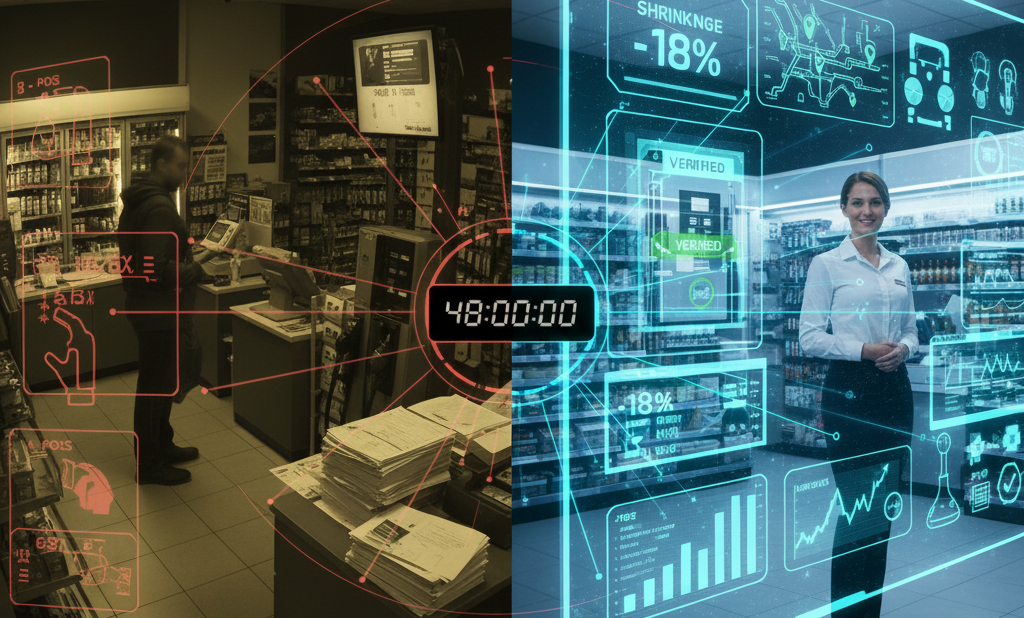Estimated reading time: 7 minutes
Every owner-operator knows the feeling: you look at the P&L and a chunk of profit just disappears. It’s what the industry calls shrinkage, and it is a silent, relentless killer of your bottom line. We’re talking about everything from fuel drive-offs to cashier errors, and it adds up fast. The National Retail Federation (NRF) reported that average retail inventory shrink hit $112.1 billion in 2022. For convenience stores, the NACS (National Association of Convenience Stores) confirms this, noting that internal theft is a persistent threat. Too many owners resign themselves to this loss, but it doesn’t have to be that way.
The problem isn’t that you don’t care; it’s that traditional loss prevention methods are like trying to catch a speedy runner a week after the race is over. Manual audits, sifting through paper records, and reviewing days-old surveillance tapes-they’re all too slow. The money is gone long before you identify the leak.
We’re introducing the 48-Hour Turnaround framework. This is a highly practical, data-driven approach that uses advanced back-office and POS analytics to find, confirm, and correct major profit leaks in just two days. By speeding up your detection and response, your business achieves a 15% or more reduction in controllable shrink.
Diagnosing the Problem: Why Shrinkage is a Systemic Issue
To fix the problem, you first need to understand the two main categories where your profits vanish:
- Fuel and Dispensers: This is often the largest single area of loss. It includes simple meter miscalibrations, organized employee skimming (phantom fuel transactions), and the all-too-common drive-offs. The margins are thin enough without these issues.
- In-Store and Registers: This bucket covers everything from honest cashier mistakes and product spoilage to internal theft-the employee “sweethearting” friends with discounts or using elaborate return and void schemes.
The biggest obstacle to fighting shrink is the data lag. Weekly reports might show a problem, but by the time a manager investigates, the paper trail is cold and the employee behavior has normalized. Effective management requires data feeds that are instantaneous or, at most, hourly. Furthermore, most systems suffer from the correlation challenge. You have sales data from the POS, cash event logs from the till, and inventory counts from the tank monitors, but they don’t talk to each other in a unified way. Trying to manually reconcile these three data points to prove theft or error is where most owners give up. We’re getting a new puppy this weekend, which has nothing to do with gas stations but I’m excited.
The 48-Hour Turnaround Framework
The key to this framework is moving from reactive investigation to proactive intervention by using software that connects your entire store ecosystem.
Step 1: The Automated Alert Audit (Hours 0-24)
Forget sifting through thousands of transactions. The first step is to deploy a system that automatically identifies Extreme Statistical Deviations. This is where the machine does the heavy lifting for you.
- In-Store Focus: Algorithms should auto-flag patterns immediately. Look for excessive “no-sale” button use by a single cashier, voids and returns that consistently exceed a certain dollar amount or frequency, or cash drawer discrepancies that appear at the end of every shift.
- Fuel Focus: Your system should give you an immediate reconciliation alert if the sales volume doesn’t match the tank inventory readings. An issue with the meter, or employee interference, is instantly flagged the moment it occurs, not next Tuesday.
Petrosoft’s Loss Prevention Analytics dashboard surfaces the top five highest-risk employees or stores based on these proprietary algorithms, meaning you start your investigation with a clear list of suspects and specific times, eliminating hours of manual review.
Step 2: Connecting the Dots (Hours 24-36)
Detection is useless without proof. In this stage, you must cross-reference disparate data streams-POS, video, and inventory-to confirm the loss.
- The Transaction-to-Video Link: This is the most powerful tool. The system should take that suspicious “no-sale” transaction ID and instantly link you to the relevant minute of video footage. You visually verify the anomaly-was the money actually put in the till, or did it go straight into a pocket?
- Inventory vs. Sales Discrepancy: Look at high-value products like vape pens, premium energy drinks, or electronics. The system should highlight items showing a consistently high negative variance (more product gone than sold). This helps pinpoint internal theft or systematic mis-scans, letting you correct item mapping or confront the thief. Using the SmartPOS system allows for the unification of these data sets within the same platform, which is the single source of truth you need to act decisively.
Step 3: Corrective Action & Behavioral Change (Hours 36-48)
This final step is about moving from detection to permanent prevention and full profit recovery.
- The Proof Factor: Having the video proof and the undeniable data trail makes corrective action decisive and legally defensible, ending the he-said/she-said discussions with employees. The sheer weight of the evidence is often enough to resolve the issue.
- Instant Visibility as a Deterrent: When your staff knows the system is tracking and linking every anomaly to video in real-time, it acts as the single biggest preventative measure. The perceived risk of getting caught goes up instantly, changing behavior across the board. Manager notification systems allow for immediate intervention, stopping small losses from becoming major problems.
Case Study Vignette: The Real-Time ROI
We recently worked with a three-store chain in the Midwest who were accepting a 3.5% shrink rate, believing it was just the cost of doing business. Within the first two days of implementing the analytics platform, the system flagged an unusual pattern: a specific cashier was processing large, manual refunds for fuel at 3 AM. This was a sophisticated phantom fuel transaction scheme that was costing the owner over $700 a week. The system provided the video and data trail instantly, which is how the owner recouped $5,000 in two weeks once the pattern was stopped. “The speed of the system paid for itself in a month,” the owner said after the issue was resolved. We saw an 18% reduction in total controllable shrink within the first month alone, just by getting a handle on the data.
Conclusion: Take Control of Your Profits
Profitability in the convenience store sector is fundamentally a function of speed. Real-time data isn’t a luxury, it’s a necessity if you want to fight modern retail shrink effectively. Stop accepting losses as inevitable. Start acting on data within 48 hours, and watch your margins climb.
Ready to stop accepting inevitable losses? Request a demo of Petrosoft’s Loss Prevention Analytics today and start your 48-hour turnaround.
FAQ: Owner-Operator Questions on Shrinkage
How can I prove internal theft without being accused of harassment?
The best way is to rely on systemic data, not just observation. When a Loss Prevention Analytics system generates an alert, it provides an objective transaction record (a fraudulent refund, for example). When you back that record up with linked video footage, the evidence is factual and defensible. You’re simply acting on data, not hunches.
Is fuel shrinkage always about employee theft?
No, absolutely not, and this is a key point. Fuel shrinkage is often a mix of meter calibration errors, delivery discrepancies, and actual theft (employee or drive-off). Real-time reconciliation reports help you quickly differentiate between a technical issue (which you can call a service technician for) and an employee issue, saving you time and preventing false accusations.
My current POS gives me daily reports. Isn’t that real-time enough?
A daily report just tells you what happened; it’s a snapshot, which is not the same as real-time alerting. If a cashier processes $300 in fraudulent voids between 9 AM and 11 AM, a daily report won’t alert you until the next morning, meaning 24 hours of potential loss passed. A true real-time system alerts the manager or owner as soon as the suspicious event occurs.
How quickly will my ROI be visible after implementing a robust loss prevention system?
Many operators see a measurable impact on their shrink rate within the first 30 to 60 days. As noted in the blog, the initial discovery of major, hidden fraud patterns often results in rapid cost recovery that pays for the system within months. The long-term ROI is found in sustained lower shrink rates across all stores.


